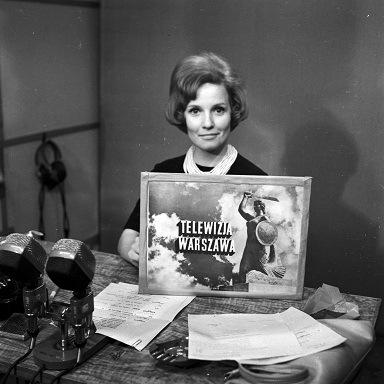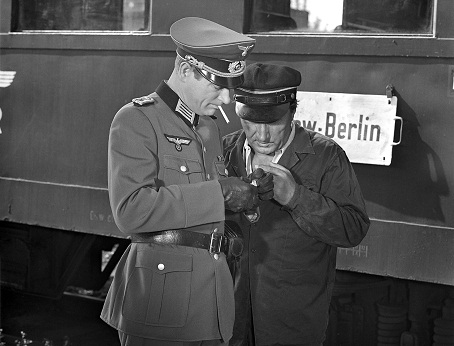TV in Poland
Early History
The technology of transmitting moving pictures was discussed in Poland as early as the late 19th century but it was not until 1929 that the first test transmission took place. The following decade witnessed pioneering and extensive research into the technology allowing for the first broadcast for the reception by television sets on 5 October 1938. A film called Barbara Radziwilowna (1936, dir. Jozef Lejtes) was transmitted from the Prudential building – the highest building in Warsaw at the time – and it was received in a 30 km radius (Grzelewska 2001: 264-265). There were, however, only a few television sets, located in some of the main state offices in Warsaw, and a few sets in private homes. This early success of broadcasting encouraged further research and the first regular transmissions were scheduled to start in 1941. The outbreak of WWII curtailed these plans and the development of television resumed only after the end of the war (Pikulski, 2002: 7-10). The crowning achievement of the post-war research into television was an exhibition that opened in Warsaw in December 1951, which presented to the general public the first television sets and demonstrated the unique qualities of the medium. The visitors could watch a 10-minute programme, either a performance or a theatrical play, received on 6 independent television screens whilst witnessing the work of the technicians behind a glass wall making the broadcast possible. The exhibition lasted until 20 January 1952 and attracted a considerable amount of interest, thus contributing to the popularity of television in Poland. The inaugural programme in the post-war history of Polish television was broadcast on 25 October 1952 at 7 pm. This 30-minute transmission was received by 24 Leningrad television sets with 12x18 cm screens located in the dayrooms of the biggest workplaces around the country (Grzelewska 2001: 264). The first feature film, a Soviet action movie, Serebristaya pyl (1953, dir. Pavel Armand, Abram Room) was broadcast in 1954 (Pikulski, 2002: 27).
Development of a National Infrastructure
In 1952, the first year of the existence of what would later become known as Program 1 (the First Programme), there were no regular broadcasts but only occasional short programmes, consisting of performances by actors from the theatre and cinema, poets and athletes. The first regular weekly half-hour broadcasts were introduced in 1953 and scheduled to air every Friday at 5pm (Pokorna-Ignatowicz 2003: 43, Grzelewska 2001: 266). Initially television was centred in Warsaw, but in 1956 the first regional centre for television was created in Lodz. This sparked an enormous interest in television and seven new regional television centres were created as a consequence in the late 1950s (Koziel 2003: 23-25). Television became a national medium in 1958 when the first nation-wide programme was broadcast, first from Warsaw and then re-transmitted by other regional centres. By the end of the 1950s Polish television employed 786 people. On December 8, 1960 the first regulatory body for the medium of television was established - Komitet do Spraw Radia i Telewizji - Polskie Radio i Telewizja (the Committee for Radio and Television) (Grzelewska 2001: 278).

As the national infrastructure developed, so did the broadcasting technology. In the early 1970s, the first channel was broadcasting seven days a week from between 8 and 10am through to 11pm, usually with two hour-long breaks in broadcasts. In 1970, the second channel – Program 2 – was launched, broadcasting five days a week initially, from around 6pm to a little after 10:30pm (Grzelewska 2001: 290). Meanwhile, Program 1 experimented with colour broadcasts, using the French SECAM system, abandoning black and white transmissions entirely in 1978 (Grzelewska 2001: 292). By 1980, Program 1 was broadcasting up to 17 hours of programming per day, while Program 2 offered up to 11 hours per day (Pokorna-Ignatowicz 2003: 185).
Over the course of the 1950s and 1960s, as the technology and infrastructure developed, television acquired enormous popularity. In 1953, there were only 80 Leningrad television sets imported. Over the course of two years, this number grew to 10,000 sets in 1955. Such enormous interest in television was reflected in heightened efforts to produce the equipment for the reception of television programming domestically; the first Polish TV set called Wisla became available in 1956. From that point onwards, the number of receivers grew exponentially. By the end of 1960s there were 3.5 million registered television sets (Grzelewska 2001: 267, 279).
Programmes
Polish television quickly turned to the theatre in seeking ideas and inspiration. Classic and contemporary original dramas were broadcast, along with book dramatizations, either as live theatrical performances or recorded stage plays (Konczak 2008: 68). Quite early on, in 1956, a special staff of actors and producers was established to fulfil the growing demand for this type of programming. As a result, Teatr Telewizji (TV Theatre, 1956– ) was introduced as a stable slot in the television schedule. In the second half of the 1950s, Teatr Telewizji would prepare around 40 premieres a year (Grzelewska 2001: 269).
An area where Polish television was particularly strong was cultural programming that aimed to promote art and generate interest in high culture. A staple programme of this genre was Kronika Kulturalna (Cultural Chronicles), which discussed topics relating to film, theatre and literature, and Pegaz (Pegasus, 1959–2004), which tackled issues from current affairs to cultural events. Polish television also invested heavily in educational programming for both adults and children, providing coverage of university lectures, programming on art history, television series meant to offer advice on driving, and a rich offer of programming on agriculture (Grzelewska 2001: 284). In light of the ample range of culture and education programmes Andrzej Koziel refers to the early years of Polish television as ‘an artistic phenomenon’ (quoted in Grzelewska 2001: 268).
Entertainment programming also constituted a rich and varied segment of Polish television output from its early years. A landmark in this respect was Kabaret Starszych Panow (Cabaret of Elderly Gentlemen, 1958–1966), a comedy show that provided a ‘delicate mockery of the communist reality’ (Haltof 2002: 140). The Polish audience also had their own talk-show Tele-Echo (TV-Echo, 1956-1981), based on French Tele Paris, as early as 1956 (Grzelewska 2001: 272). Tele-Echo’s host Irena Dziedzic became one of the first iconic television personalities in the country. Another type of entertainment programming that accounted for a sizeable proportion of domestic production from early on were game shows, including the show Gwiazdy Estrady (Stars of the Stage) that showcased performative talents of one chosen artist per episode (Grzelewska 2001: 273) and quiz shows such as Tele-Zgadula (TV Guessing Game), which pitted teams against each other in performing tasks to win prizes (Grzelewska 2001: 274).
The 1960s was also the period that saw the growing importance of fictional genres of entertainment. The first Polish television series of this type – Barbara i Jan (Barbra and John, 1965) – aired in 1965. Soon other series followed (Pikulski 2002: 78, 84-85), including Wojna Domowa (1965–1966), which focused on everyday life and offered telling insights into Polish family life. Another theme often addressed by Polish television fiction in the 1960s, but also later, was World War Two, prominent in series such as Czterej Pancerni i Pies (Four Tank Men and a Dog, 1966–1970) and Stawka Wieksza Niz Zycie (Stakes Higher Than Life, 1968). All of these television series developed large and loyal audiences and are remembered fondly to this day. It is also worth noting that throughout the 1960s, Polish television was rather open to Western television fiction; during this period, the first American imports found their way to Polish homes, including Dr. Kildare (1961–1966, NBC) and Bonanza (1959–1973, NBC) (Grzelewska 2001: 288).

Political Control
Until the 1970s, Polish television programming consisted mainly of entertainment, television fiction and educational and cultural programming, with a marginal amount of news programming (Pokorna-Ignatowicz, 2003: 50-51). All these programmes were not as heavily laden with explicit political propaganda as their counterparts in the Soviet bloc, even though they did pay particular attention to issues of particular relevance to socialist values, including the growth of industry, labour productivity and agriculture (Paulu 1974: 481). The character of Polish broadcasting began to change in the late 1960s, especially after the wave of anti-communist protests involving students and intellectuals that swept the country in March 1968, and the ensuing repressions.
The 1970s saw a growing politicization of television content, and of news in particular, which now became part of the battle against the early workers’ movements that later coalesced into Solidarity movement (Grzelewska 2001: 286, 292). Some current affairs programmes were cancelled and replaced by political content emphasizing the economic accomplishments of the communist system (Grzelewska 2001: 302). This shift transformed television into the main tool of Party-driven persuasion, feeding the viewers with false news of the successes of the Party despite the growing crisis in the country. Other functions that television previously served such as to educate and to support domestic culture were abandoned. As a result, the amount of news and political programming increased and entertainment became as Pokorna-Ignatowicz claims ‘poorly represented’ (Pokorna-Ignatowicz 2003: 104).
The following decade did not bring any significant changes in the character of Polish television and Andrzej Koziel calls the 1980s the most difficult period for Polish broadcasting (Grzelewska 2001: 314). Following the rise of tensions with Solidarity, the introduction of martial law on 13 December 1981 was the key defining moment of the decade. This had a consequential effect on television, interrupting the regular broadcasts, and conditioned the mood of Polish television for the whole decade. Program 1 reactivated broadcasts within days, while Program 2 remained off air for nearly two years. Television remained the main tool of the political fight against the Solidarity movement, aimed at undermining the status of the opposition, blaming them for the deteriorating situation in the country. Still, television remained the dominant mass medium with 9.5 million viewers in 1985 (Grzelewska 2001: 314).
Bibliography
Paulu, Burton. 1974. Radio and Television Broadcasting in Eastern Europe. Minneapolis, MN: University of Minnesota Press.
Grzelewska, Danuta, Rafal Habielski, Andrzej Koziel, Janusz Osica, Lidia Piwonska-Pukalo. 2001. Prasa, Radio i telewizja w Polsce. Zarys Dziejow. Warszawa: Elipsa.
Haltof, Marek. 2002. Polish National Cinema. Berghahn Books.
Konczak, Jaroslaw. 2008. Od Tele-Echa do Polskiego Zoo. Ewolucja Programu TVP. Warszawa: Wydawnictwa Akademickie i Profesjonalne.
Koziel, Andrzej. 2003. Za Chwile Dalszy Ciag Programu… Telewizja Polska Czterech Dekad. 1952-1989. Warszawa: Oficyna Wydawnicza ASPRA-JR.
Pikulski, Tadeusz. 2002. Prywatna Historia Telewizji Publicznej. Warszawa: Muza.
Pokorna-Ignatowicz, Katarzyna. 2003. Telewizja w systemie politycznym i medialnym PRL. Miedzy Polityka a Widzem. Kraków: Wydawnictwo Uniwersytetu Jagiellonskiego.
